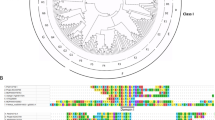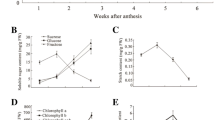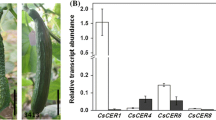Abstract
Key message
Overexpression of CsERF025 induces fruit bending by promoting the production of ethylene.
Abstract
Cucumber fruit bending critically affects cucumber quality, but the mechanism that causes fruit bending remains unclear. To better understand this mechanism, we performed transcriptome analyses on tissues from the convex (C1) and concave (C2) sides of bending and straight (S) fruit at 2 days post anthesis (DPA). We identified a total of 281 differentially expressed genes (DEGs) from both the convex and concave sides of bent fruit that showed significantly different expression profiles relative to straight fruits. Of these 281 DEGs, 196 were up-regulated (C1/S_C2/S) and 85 were down-regulated (C1/S_C2/S). Among the 196 up-regulated DEGs, the transcriptional levels of genes related to ethylene biosynthesis and signaling pathways were significantly higher in bending fruit compared with straight fruit. CsERF025 showed the largest difference in expression between bending and straight fruit. CsERF025 is an AP2/ERF gene encoding a protein that localizes to the nucleus. Overexpression of this gene increased the bending rate of cucumber fruits and increased the angle of bending. CsERF025 increased both the expression of ethylene biosynthesis-related genes and the production of ethylene. The application of exogenous 1-aminocyclopropane-l-carboxylic acid (ACC) to straight fruits from control plants promoted fruit bending. Thus, CsERF025 enhances the production of ethylene and thereby promotes fruit bending in cucumber.







Similar content being viewed by others
References
Alba R, Payton P, Fei Z, McQuinn R, Debbie P, Martin GB et al (2005) Transcriptome and selected metabolite analyses reveal multiple points of ethylene control during tomato fruit development. Plant Cell 17:2954–2965. doi:10.1105/tpc.105.036053
Chen S, Songkumarn P, Liu J, Wang GL (2009) A versatile zero background T-vector system for gene cloning and functional genomics. Plant Physiol 150:1111–1121. doi:10.1104/pp.109.137125
Chervin C, El-Kereamy A, Roustan JP, Latché A, Lamon J, Bouzayen M (2004) Ethylene seems required for the berry development and ripening in grape, a non-climacteric fruit. Plant Sci 167:1301–1305. doi:10.1016/j.plantsci.2004.06.026
Colle M, Weng Y, Kang Y, Ophir R, Sherman A, Grumet R (2017). Variation in cucumber (Cucumis sativus L.) fruit size and shape results from multiple components acting pre-anthesis and post-pollination. Planta 1–18. doi:10.1007/s00425-017-2721-9
Du Z, Zhou X, Ling Y, Zhang Z, Su Z (2010) agriGO: a GO analysis toolkit for the agricultural community. Nucleic Acids Res 38:W64–WW70. doi:10.1093/nar/gkq310
Fulgosi H, Soll J, de Faria Maraschin S, Korthout HA, Wang M, Testerink C (2002) 14-3-3 Proteins and plant development. Plant Mol Biol 50:1019–1029. doi:10.1023/A:1021295604109
Ge C (2008) Evaluation of main germplasm resources about different degree of bending in cucumber. Dissertation, Northeast Agricultural University
González-Ballester D, Casero D, Cokus S, Pellegrini M, Merchant SS, Grossman AR (2010) RNA-seq analysis of sulfur-deprived Chlamydomonas cells reveals aspects of acclimation critical for cell survival. Plant Cell 22:2058–2084. doi:10.1105/tpc.109.071167
Griffiths A, Barry C, Alpuche-Solis AG, Grierson D (1999) Ethylene and developmental signals regulate expression of lipoxygenase genes during tomato fruit ripening. J Exp Bot 50:793–798. doi:10.1093/jxb/50.335.793
Gu C, Guo ZH, Hao PP, Wang GM, Jin ZM, Zhang SL (2017) Multiple regulatory roles of AP2/ERF transcription factor in angiosperm. Bot Stud 58:6. doi:10.1186/s40529-016-0159-1
Han Y, Kuang J, Chen J, Liu X, Xiao Y, Fu C et al (2016) Banana transcription factor MaERF11 recruits histone deacetylase MaHDA1 and represses the expression of MaACO1 and expansins during fruit ripening. Plant Physiol 171:1070–1084. doi:10.1104/pp.16.00301
Hao D, Yamasaki K, Sarai A, Ohme-Takagi M (2002) Determinants in the sequence specific binding of two plant transcription factors, CBF1 and NtERF2, to the DRE and GCC motifs. BioChemistry 41:4202–4208. doi:10.1021/bi015979v
Hu JL (2012) Botany. Beijing, China
Huang S, Li R, Zhang Z, Li L, Gu X, Fan W et al (2009) The genome of the cucumber, Cucumis sativus L. Nat Genet 41:1275–1281. doi:10.1038/ng.475
Kanahama K, Saito T (1984) Effect of planting density and shading on the fruit curvature in cucumber. J Jpn Soc Hort Sci 53:331–337. doi:10.2503/jjshs.53.331
Kumar S, Stecher G, Tamura K (2016) MEGA7: molecular evolutionary genetics analysis version 7.0 for bigger datasets. Mol Biol Evol 33:1870–1874. doi:10.1093/molbev/msw054
Lee JM, Joung JG, McQuinn R, Chung MY, Fei Z, Tieman D et al (2012) Combined transcriptome, genetic diversity and metabolite profiling in tomato fruit reveals that the ethylene response factor SlERF6 plays an important role in ripening and carotenoid accumulation. Plant J 70:191–204. doi:10.1111/j.1365-313X.2011.04863.x
Lescot M, Déhais P, Thijs G, Marchal K, Moreau Y, Van de Peer Y et al (2002) PlantCARE, a database of plant cis-acting regulatory elements and a portal to tools for in silico analysis of promoter sequences. Nucleic Acids Res 30:325–327. doi:10.1093/nar/30.1.325
Li Y, Zhu B, Xu W, Zhu H, Chen A, Xie Y et al (2007) LeERF1 positively modulated ethylene triple response on etiolated seedling, plant development and fruit ripening and softening in tomato. Plant Cell Rep 26:1999–2008. doi:10.1007/s00299-007-0394-8
Liu M, Pirrello J, Kesari R, Mila I, Roustan JP, Li Z et al (2013) A dominant repressor version of the tomato Sl-ERF.B3 gene confers ethylene hypersensitivity via feedback regulation of ethylene signaling and response components. Plant J 76:406–419. doi:10.1111/tpj.12305
Liu M, Diretto G, Pirrello J, Roustan JP, Li Z, Giuliano G et al (2014) The chimeric repressor version of an ethylene Response Factor (ERF) family member, Sl-ERF.B3, shows contrasting effects on tomato fruit ripening. New Phytol 203:206–218. doi:10.1111/nph.12771
Miao M, Yang X, Han X, Wang K (2011) Sugar signalling is involved in the sex expression response of monoecious cucumber to low temperature. J Exp Bot 62:797–804. doi:10.1093/jxb/erq315
Mortazavi A, Williams BA, McCue K, Schaeffer L, Wold B (2008) Mapping and quantifying mammalian transcriptomes by RNA-SEq. Nat Methods 5:621–628. doi:10.1038/nmeth.1226
Nakatsuka A, Murachi S, Okunishi H, Shiomi S, Nakano R, Kubo Y et al (1998) Differential expression and internal feedback regulation of 1-aminocyclopropane-1-carboxylate synthase, 1-aminocyclopropane-1-carboxylate oxidase, and ethylene receptor genes in tomato fruit during development and ripening. Plant Physiol 118:1295–1305. doi:10.1104/pp.118.4.1295
Ohme-Takagi M, Shinshi H (1995) Ethylene-inducible DNA binding proteins that interact with an ethylene-responsive element. Plant Cell 7:173–182. doi:10.1105/tpc.7.2.173
Patel RK, Jain M (2012) NGS QC Toolkit: a toolkit for quality control of next generation sequencing data. PLoS ONE 7:e30619. doi:10.1371/journal.pone.0030619
Robinson MD, McCarthy DJ, Smyth GK (2010) edgeR: a Bioconductor package for differential expression analysis of digital gene expression data. Bioinformatics 26:139–140. doi:10.1093/bioinformatics/btp616
Sakuma Y, Liu Q, Dubouzet JG, Abe H, Shinozaki K, Yamaguchi-Shinozaki K (2002) DNA-binding specificity of the ERF/AP2 domain of Arabidopsis DREBs, transcription factors involved in dehydration and cold-inducible gene expression. Biochem Biophys Res Commun 290:998–1009. doi:10.1006/bbrc.2001.6299
Sato T, Takiguchi T, Matsuura K, Narimatsu J, Mizuno N (2003) Effects of high temperature caused by non-ventilation of greenhouse on the growth and prevention of disease and insect damage in summer-grown cucumber. Engei Gakkai Zasshi 72:56–63. doi:10.2503/jjshs.72.56
Schmittgen TD, Livak KJ (2008) Analyzing real-time PCR data by the comparative C(T) method. Nat Protoc 3:1101–1108. doi:10.1038/nprot.2008.73
Silk WK, Erickson RO (1979) Kinematics of plant growth. J Theor Biol 76:481–501. doi:10.1016/0022-5193(79)90014-6
Tan J, Tao Q, Niu H, Zhang Z, Li D, Gong Z et al (2015) A novel allele of monoecious (m) locus is responsible for elongated fruit shape and perfect flowers in cucumber (Cucumis sativus L.). Theor Appl Genet 128:2483–2493. doi:10.1007/s00122-015-2603-0
Trebitsh T, Staub JE, O’Neill SD (1997) Identification of a 1-aminocyclopropane-1-carboxylic acid synthase gene linked to the female (F) locus that enhances female sex expression in cucumber. Plant Physiol 113:987–995. doi:10.1104/pp.113.3.987
Vandenbussche F, Petrášek J, Zadnikova P et al (2010) The auxin influx carriers AUX1 and LAX3 are involved in auxin-ethylene interactions during apical hook development in Arabidopsis thaliana seedlings. Development 137:597–606. doi:10.1242/dev.040790
Varshney RK, Chen W, Li Y, Bharti AK, Saxena RK, Schlueter JA et al (2011) Draft genome sequence of pigeonpea (Cajanus cajan), an orphan legume crop of resource-poor farmers. Nat Biotechnol 30:83–89. doi:10.1038/nbt.2022
Wan H, Zhao Z, Qia C, Sui Y, Malik AA, Chen J (2010) Selection of appropriate reference genes for gene expression studies by quantitative real-time polymerase chain reaction in cucumber. Anal Biochem 399:257–261. doi:10.1016/j.ab.2009.12.008
Wang A, Tan D, Takahashi A, Li TZ, Harada T (2007) MdERFs, two ethylene-response factors involved in apple fruit ripening. J Exp Bot 58:3743–3748. doi:10.1093/jxb/erm224
Wang DH, Li F, Duan QH, Han T, Xu ZH, Bai SN (2010) Ethylene perception is involved in female cucumber flower development. Plant J 61:862–872. doi:10.1111/j.1365-313X.2009.04114.x
Wang LL, Zhang P, Qin ZW, Zhou XY (2014) Proteomic analysis of fruit bending in cucumber (Cucumis sativus L.). J Integr Agricultur 13:963–974. doi:10.1016/S2095-3119(13)60406-2
Xiao YY, Chen JY, Kuang JF, Shan W, Xie H, Jiang YM et al (2013) Banana ethylene response factors are involved in fruit ripening through their interactions with ethylene biosynthesis genes. J Exp Bot 64:2499–2510. doi:10.1093/jxb/ert108
Xu Y, Qin Z, Zhou X (2013) Cloning and expression analysis of fruit bending related gene Cs14-3-3 in cucumber. Acta Hort Sin 5:11. doi:10.16420/j.issn.0513-353x.2013.05.012
Yoo SD, Cho YH, Sheen J (2007) Arabidopsis mesophyll protoplasts: a versatile cell system for transient gene expression analysis. Nat Protoc 2:1565–1572. doi:10.1038/nprot.2007.199
Zhang P (2009) Mapping Quantitative Traits Loci and Proteomics Studies on Bending of Cucumber Fruit. Dissertation, Northeast Agricultural University
Zhang Y, Zhang X, Liu B, Wang W, Liu X, Chen C et al (2014) A GAMYB homologue CsGAMYB1 regulates sex expression of cucumber via an ethylene-independent pathway. J Exp Bot 65:3201–3213. doi:10.1093/jxb/eru176
Acknowledgements
This study was funded by the National Natural Science Foundation of China (31401863) and the Young Talents Project of Northeast Agricultural University (14QC12). There are no financial competing interests. We acknowledge Associate Professor Yongguang Li (Key Laboratory of Northeastern Soybean Biology and Genetic Breeding of the Ministry of Agriculture, China) for providing the pCXSN-1250 vector. We thank Professor Huazhong Ren (College of Agronomy and Biotechnology, China Agricultural University, Beijing), who provided the method for the genetic transformation of cucumber.
Author information
Authors and Affiliations
Contributions
CW and ZQ designed and conceived the research, and CW, MX and XZ performed the experiments. CL, SL, DL and YX analyzed the sequencing data. CW wrote the entire manuscript, and ZQ edited the manuscript.
Corresponding author
Electronic supplementary material
Below is the link to the electronic supplementary material.
Rights and permissions
About this article
Cite this article
Wang, C., Xin, M., Zhou, X. et al. The novel ethylene-responsive factor CsERF025 affects the development of fruit bending in cucumber. Plant Mol Biol 95, 519–531 (2017). https://doi.org/10.1007/s11103-017-0671-z
Received:
Accepted:
Published:
Issue Date:
DOI: https://doi.org/10.1007/s11103-017-0671-z




